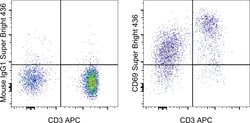Learn More
CD69 Monoclonal Antibody (FN50), Super Bright™ 436, eBioscience™, Invitrogen™
Mouse Monoclonal Antibody
$391.00
Specifications
| Antigen | CD69 |
|---|---|
| Clone | FN50 |
| Concentration | 5 μL/Test |
| Applications | Flow Cytometry |
| Classification | Monoclonal |
| Catalog Number | Mfr. No. | Quantity | Price | Quantity & Availability | |||||
|---|---|---|---|---|---|---|---|---|---|
| Catalog Number | Mfr. No. | Quantity | Price | Quantity & Availability | |||||
62-069-942

|
Invitrogen™
62069942 |
100 Tests |
Each of 1 for $391.00
|
|
|||||
Description
Description: The FN50 monoclonal antibody reacts with human CD69, also known as very early activation antigen (VEA). CD69 is approximately 30 kDa and is expressed on the cell-surface as a disulfide-linked dimer. CD69 is rapidly upregulated upon activation and expressed on lymphocytes, monocytes and platelets. Applications Reported: This FN50 antibody has been reported for use in flow cytometric analysis. Applications Tested: This FN50 antibody has been pre-titrated and tested by flow cytometric analysis of stimulated normal human peripheral blood cells. This can be used at 5 μL (0.125 μg) per test. A test is defined as the amount (μg) of antibody that will stain a cell sample in a final volume of 100 μL. Cell number should be determined empirically but can range from 10^5 to 10^8 cells/test. Super Bright 436 can be excited with the violet laser line (405 nm) and emits at 436 nm. We recommend using a 450/50 bandpass filter, or equivalent. Please make sure that your instrument is capable of detecting this fluorochrome. When using two or more Super Bright dye-conjugated antibodies in a staining panel, it is recommended to use Super Bright Complete Staining Buffer (Product # SB-4401) to minimize any non-specific polymer interactions. Please refer to the datasheet for Super Bright Staining Buffer for more information. Excitation: 405 nm; Emission: 436 nm; Laser: Violet Laser Super Bright Polymer Dyes are sold under license from Becton, Dickinson and Company.
CD69 (AIM, Active Inducer Molecule) is a gp28/34 disulfide bonded homodimer with a molecular weight of 60 kDa under non-reducing conditions. CD69 contains one or two N linked oligosacaride and the molecule is present on activated platelets. In normal peripheral blood a variable percentage of cells express the CD69 antigen, and it is involved in lymphocyte signal transduction. Expression CD69 is induced upon activation of T lymphocytes, and may play a role in proliferation. Furthermore, the protein may act to transmit signals in natural killer cells and platelets. Alternative splicing results in multiple transcript variants of CD69. Diseases associated with CD69 dysfunction include coccidiodomycosis and asthma.Specifications
| CD69 | |
| 5 μL/Test | |
| Monoclonal | |
| Liquid | |
| RUO | |
| Q07108 | |
| CD69 | |
| Primary | |
| 4°C, store in dark, DO NOT FREEZE! | |
| CD69 |
| FN50 | |
| Flow Cytometry | |
| Super Bright 436 | |
| Mouse | |
| Human | |
| 969 | |
| IgG1 κ | |
| Affinity chromatography | |
| Antibody |
The Fisher Scientific Encompass Program offers items which are not part of our distribution portfolio. These products typically do not have pictures or detailed descriptions. However, we are committed to improving your shopping experience. Please use the form below to provide feedback related to the content on this product.

